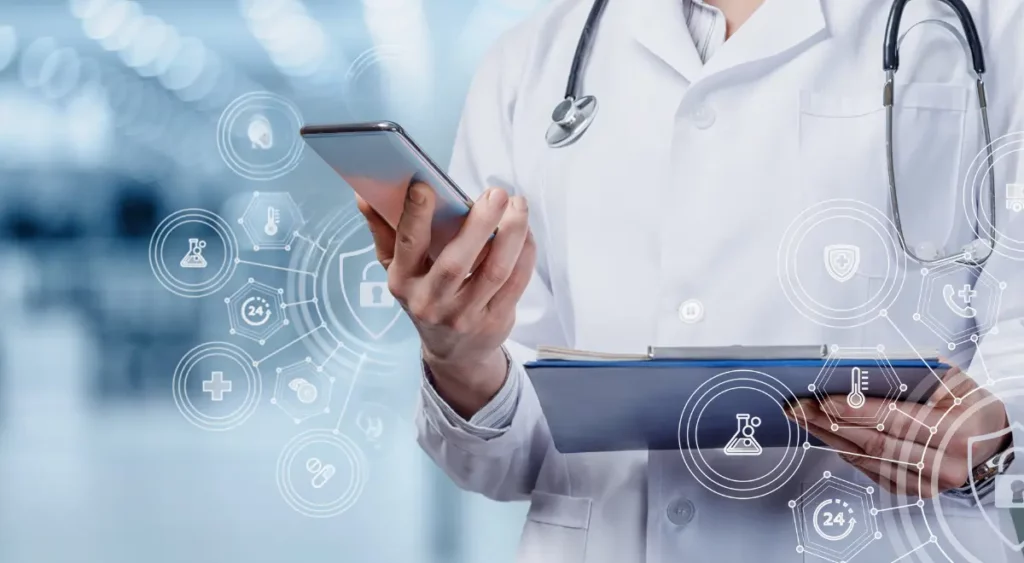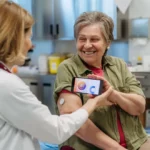The Importance of Data Encryption and Cybersecurity in RPM Systems

Remote Patient Monitoring (RPM) relies on connected devices and patient data exchange. Protecting this sensitive information with strong encryption and cyber security safeguards is critical for HIPAA compliance, patient trust, and the safe growth of digital healthcare.
The introduction of technologically advanced remote monitoring devices and care management platforms, such as Remote Patient Monitoring (RPM) has greatly improved the way healthcare providers approach and deliver patient care. It allows monitoring patients’ health remotely and in real time, without any need to visit the doctor’s clinic.
RPM systems help manage chronic conditions, track vital signs, and enable timely interventions, improving patient outcomes and reducing healthcare costs in the long run. However, this convenience comes with significant risks, primarily related to the security and privacy of the sensitive health data they collect.
Table of Contents
ToggleThe Role of Data Encryption in RPM Systems
Data encryption is an effective way to protect sensitive data from being accessed by unauthorized persons or organizations. In the context of RPM, encryption keeps patients’ information strictly confidential even if being intercepted during transmission. Data encryption converts readable data into coded strings of information that can only be decoded through a special decryption key. Since the access to the key is only with the healthcare provider, it makes it difficult for any unauthorized individual to gain access to the information.
There are two major types of encryption that are relevant to RPM systems:
- End-to-End Encryption (E2EE): This type of end to end data encryption protects patient data, ensuring that when it is created on the patient’s device, it can subsequently only be decrypted by the healthcare provider. This is important for protecting data transferred from the patient’s device to the healthcare system.
- Data-at-Rest Encryption (DRE): This type of encryption secures data stored in databases or cloud storage, thereby preventing unauthorized access to the data whenever it is not being used. Data-at-rest encryption manages to protect and secure the patient data, even if a cybercriminal manages to gain access to the anti-intrusion and data storage systems.
Need for Incorporating Data Encryption in RPM Systems
- Patient Privacy Protection: Patient privacy is an integral and ethical principle that needs to be followed and implemented in all digital health platforms. When applied to patient data, encryption guarantees that every piece of information is kept confidential with limited access to authorized persons only.
- Regulatory Compliance: In the US, healthcare organizations are mandated to adhere to compliance regulations, including the Health Insurance Portability and Accountability Act (HIPAA). Encryption is one of the means of boosting the compliance measures through the prevention of data breaches and unauthorized access.
- Trust and Confidence: If remote care software promises data encryption, patients and healthcare providers can remain confident that the RPM systems they are adopting are safe and that the data is exchanged securely.
Best Practices in Cybersecurity for RPM Systems
Data encryption plays an important role in securing patient data but needs to work closely with cybersecurity measures for effective results. Integrated security systems are required for protection against potential risks that could threaten the integrity and performance of RPM systems. Here are some of the important cybersecurity best practices that healthcare organizations should follow to protect their RPM systems:
- Data Encryption: Encrypting data means making it unreadable to unauthorized parties. This is accomplished by encrypting a message or figures using symbolic letters or signs. This applies to both data at rest and in transit.
- Multi Factor Authentication (MFA): It refers to the use of two or more security measures to authenticate a user’s identity. Multi factor authentication provides an additional layer of protection to an RPM system.
- Intrusion Detection Systems: IDS is critical in addressing malicious phishing attempts and cybersecurity problems on over-the-cloud healthcare platforms. It addresses patient data and privacy security concerns by monitoring network traffic, identifying suspicious activity, and responding to potential threats in real time, allowing healthcare providers to handle potential security problems before any harm.
- Artificial Intelligence (AI): This system driven tool can evaluate patterns that may signal a cyber threat, enabling proactive security measures by detecting suspicious activity in real time and initiating prompt security actions.
- Regular Software Updates: Cybercriminals frequently exploit weak points in outdated software to obtain unauthorized access to systems. Regular updates and patch management helps in reducing this risk by addressing the security vulnerabilities. Healthcare providers should ensure that their RPM devices and platforms stay updated with the latest security to maintain uncompromised security.
- Firewalls and Intrusion Detection Systems (IDS): These systems monitor and manage incoming and outgoing network traffic, preventing hostile attempts to get unauthorized attempt to an RPM system. Not only this, these systems apply an extra layer of security by detecting and mitigating real time threats.
HealthArc Improves RPM System Security & Compliance
Cybersecurity risks have a significant impact on remote patient monitoring systems. Healthcare providers must understand the need of data encryption and cybersecurity in RPM systems to not only meets security standards but also enhance patient care and satisfaction.
HealthArc’s all-in-one advanced care management platform enables medical practitioners and providers to engage with their patients from a remote setting while maintaining privacy and data protection. Our RPM software is HIPAA and SOC2 compliant.
Key takeaways
- RPM involves continuous transfer of sensitive patient health data.
- Strong data encryption ensures compliance and prevents breaches.
- Cybersecurity safeguards protect against hacking and ransomware risks.
- HIPAA and CMS regulations mandate strict data protection standards.
- Secure RPM builds patient trust and reduces provider liability.
Frequently Asked Questions (FAQs)
Encryption is like a secret code that keeps private medical data safe while it’s saved on devices or sent over the internet. Only the right devices can read the code, stopping prying eyes.
RPM has to guard against hackers breaking in, ransomware that locks data until a ransom is paid, misuse of logins, and tiny leaks that let out key patient info. All of these could hurt patients and break rules.
RPM systems stick to HIPAA by adding encryption, locking systems with passwords, keeping logs of who checked what, and using secure paths for data to travel.
If nobody locks up patient data, hackers can steal it, fines can follow, patients can lose faith, and their safety can be at risk.
Providers keep data secure by using devices with encryption, requiring multiple forms of ID to log in, shielding networks with firewalls, doing routine checks, and teaching staff.
Not at all. Even encrypted data can be at risk if networks aren’t watched, APIs aren’t strong, or rules aren’t double-checked.
Patients feel comfortable using remote health tools when they believe their data is locked, scrambled, and out of reach of cyber thieves.
As more people use RPM tools, strong security can let the technology grow safely, follow the law, and keep digital health steady.
To see how our digital health platform may assist you in adhering to RPM security requirements while meeting quality standards, book a demo or contact (201) 885 5571.
Most Recent Blogs
Categories
Related Blog
- October 23, 2025 | Read Time: 12 mins
How RPM Devices Improve Hypertension and Diabetes Outcomes in Medicare Populations
Remote patient monitoring (RPM) is transforming chronic care for Medicare beneficiaries. CMS...
Learn More- August 25, 2025 | Read Time: 13 mins
How Can “One Big Beautiful Bill” Boost RPM Programs by $50B?
The “One Big Beautiful Bill,” signed July 4, 2025, directs $50B over...
Learn More- August 22, 2025 | Read Time: 17 mins
HealthArc Platform vs RPM Software Solutions
Is your healthcare organization trying to pick a remote patient monitoring solution?...
Learn More


